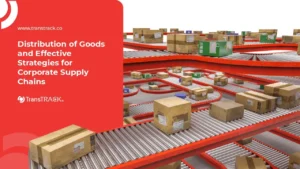Discover the Term Loading Unloading Goods in Logistics Activities
Posted on December 20, 2023 by Nur Wachda Mihmidati

In the world of logistics, the terms loading and unloading are two inseparable keywords. These two processes play an important role in ensuring that goods can move from one place to another efficiently. Without these processes, a logistics company’s operations cannot be optimized.
Understanding what loading and unloading is in depth can be key for logistics companies that want to improve efficiency and safety in the process of shipping goods.
For that, let’s explore further about the definition, differences between loading and unloading, and the stages of the process in the following article TransTRACK.
Definition of Loading and Unloading in Logistics
Loading is the process of loading or transferring goods from their place of origin into a vehicle or means of transportation. This process includes loading goods into trucks, ships, planes, or other modes of transportation. Loading is the first step that marks the journey of goods from the warehouse or storage area to the final destination.
On the other hand, unloading is the reverse process of loading. It involves moving the goods from the means of transportation to the final destination, such as a warehouse or distribution location. Unloading is a crucial stage in the supply chain, because from here, the goods will be directed to the next storage or distribution.
The difference between loading and unloading lies in the direction of goods movement. Loading focuses on the transfer of goods from the origin to the vehicle, while unloading refers to the transfer of goods from the vehicle to the final destination.
Stages of the Goods Loading Process
The loading process includes several important steps to ensure that the goods are well packaged and safe during the journey. Here are some of the steps:
Goods Inspection
Before starting the loading process, goods inspection is a very important first step. The supervisory team or logistics officer must ensure that the goods to be loaded are in good condition and in accordance with the order. This involves checking the quality, quantity, and completeness of related documents.
Arrangement of Goods
The arrangement of goods in a vehicle or transportation container is a key step to prevent damage during travel. Goods should be carefully placed according to their characteristics. Fragile or breakable items, for example, need to be placed in a safe and secure place.
Safeguarding Goods
Securing goods is a crucial stage in the loading process. The use of strapping, special padding, or barriers can prevent goods from shifting during transit. This helps avoid damage from shock or vibration during transportation.
Item Labeling
Clear and accurate labeling of goods is very important. Each item should be labeled with complete information, including product name, quantity, and any other specific information required. This makes it easier to identify and retrieve the goods at the destination.
Back Verification
The re-verification stage is conducted to ensure that all goods have been loaded in accordance with the load list. This involves a comparison between the goods on hand and the data recorded in the shipping documents. This re-verification is the final step before the vehicle leaves the loading bay.
Stages of Goods Unloading Process
The unloading process is just as important as loading to maintain the integrity of the goods. Here are some stages of the unloading process:
Coordination with the Receiving Party
Coordination of the unloading process involves effective communication between the logistics service provider and the consignee. It is important to know the estimated time of arrival and the number of goods to be received to ensure the readiness of facilities and manpower at the destination.
Removal of Goods from Vehicle
Next, the unloading process begins with the removal of goods from the transport vehicle to the destination area. The removal of goods must be done carefully to prevent damage and ensure the goods remain in good condition.
Inspection of Goods
This inspection includes checking the physical condition of the goods, the completeness of the quantity, and compliance with the shipping documents. The receiving party must ensure that the goods received are as expected and have not been damaged during the transportation process.
Sorting of Goods
Once the inspection is complete, the goods can be sorted based on their destination. The sorting process involves grouping the goods according to their category or final destination. Efficient segregation facilitates further distribution and speeds up the process of channeling to the right warehouse or storage location.
Storage or Further Distribution
When the sorting process is complete, the goods can either be temporarily stored in the warehouse or directly distributed to their final destination. This decision depends on the policies and specific needs of the receiving party.
Goods Loading & Unloading Equipment
The loading and unloading process cannot be separated from the use of the right equipment. The use of this equipment serves to facilitate the loading and unloading process. Some common equipment used include:
Forklifts
Forklifts are equipped with forks that can be lifted and lowered. The main advantage of a forklift is its ability to lift goods to a certain height, ensuring efficient arrangement in a transportation vehicle.
Conveyor Belt
Conveyor belts are automated equipment that help move goods continuously. Goods can be placed on a conveyor belt and automatically moved into a vehicle or from a vehicle to a storage area.
Pallet Jack
Pallet jacks are equipment used to move pallets of goods easily. This equipment is equipped with a fork that can be inserted under the pallet, then the pallet can be lifted and moved by pulling or pushing the equipment.
Crane
Cranes are often used to move very heavy or large items. In the context of loading and unloading, cranes can be used to lift goods from ships to docks or from trucks to warehouses.
In logistics activities, loading and unloading are not just routine stages, but the core of a smooth supply chain. With a good understanding of this concept, logistics companies can increase efficiency, reduce the risk of damage to goods, and gain an edge in market competition.
As an integrated solution, Logistic Service Integrator (LSI) from Transtrack is here to make it easy to manage the entire logistics process. With advanced technology, LSI helps optimize loading and unloading processes, increase visibility, and reduce the risk of errors.
Contact TransTRACK today, and get the benefits to improve your logistics operations.
Recent Post
Topic :
Recommended Articles

 Bahasa Indonesia
Bahasa Indonesia







